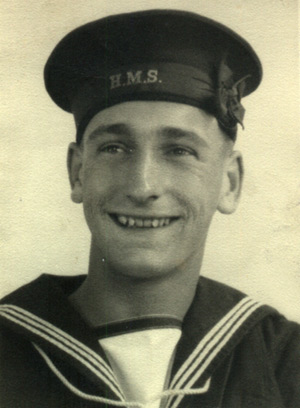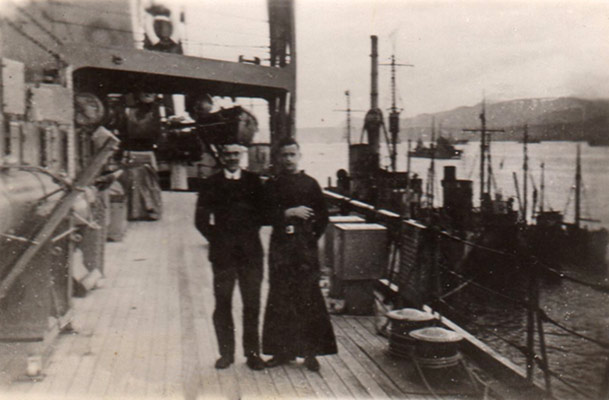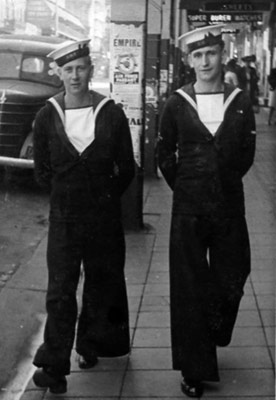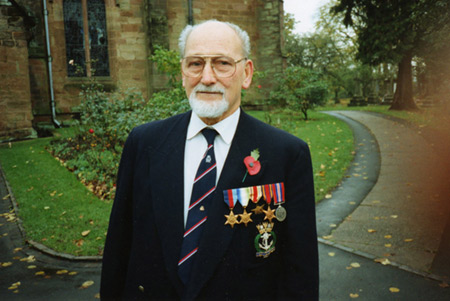






Harry
Cliffe met Marie, his future wife, in 1941 when she was just sixteen
and he was two years older working at the Co-operative store on the
corner of the street where she lived in Warrington. They married after
the war when Harry returned to his job at the Co-op. Later on they
owned their own grocery shop and bought the small house in Norley, Cheshire, where
Marie still lives today.
For a detailed account of Harry's "Navy Days" link to the 75 minute interview
with him on three reels of audio tape in the Imperial War Museum's Oral
Collection which is now available online as an audio stream. The
catalogue entry will help locate his description of service on HMS Hecla (towards the end of Reel Two) and her sinking and his rescue (Reel Three).
Harry Cliffe died in 2003 but the year before his death he wrote a brief account of his "Navy Days" including his memories of the night when HMS Hecla sank which was published by Wartime News and is republished here with their consent.
 "My ‘Navy Days’ began in July 1940 with ten weeks’ training at HMS Raleigh at Torpoint. I then transferred to the depot HMS Drake and spent a short spell on BV7 moored in Plymouth Sound as part of the Ack-ack defence but this failed to prevent the devastating Blitz of Plymouth.
"My ‘Navy Days’ began in July 1940 with ten weeks’ training at HMS Raleigh at Torpoint. I then transferred to the depot HMS Drake and spent a short spell on BV7 moored in Plymouth Sound as part of the Ack-ack defence but this failed to prevent the devastating Blitz of Plymouth.
I was soon drafted to destroyer HMS Fame
at Rosyth after an all-night train journey passing through my hometown
of Warrington at great speed to discourage ideas about a first home
visit in uniform. Fame had
been repaired after action in Norway and was under ‘sailing orders’ so
there was still no chance of any home leave. Being a young Ordinary
Seaman, I was detailed for duty as mast head lookout - easily monitored
from the bridge below! After several days hectic trials, my head and
stomach decided to accept the situation - Pussers Rum, cocoa and
Marmite butties gradually became stomach-friendly, although that
masthead bucket seemed to get higher every day.
I was off-duty on the stormy, foggy night in October 1940 when Fame led a flotilla of seven destroyers onto the rocky east coast at Whitburn. Four were severely damaged, Fame
was wrecked with the engine room on fire; smoke, steam and explosions
alerted the Home Guard to a suspected invasion. The crew was eventually
rescued by Breechers Buoy. The shell of Fame was rebuilt and recommissioned.
I returned home for my first time since joining the Navy on seven days
survivor’s leave after which I joined the newly commissioned HMS Hecla
in December 1940. She was built at John Brown’s Clydeside
shipyard and cost more than £1,000,000 (a fortune in the 1930s). Hecla
was a 12,000 ton depot ship, capable of servicing and supplying three
flotillas of 24 destroyers for a year in remote parts of the world
where dockyard facilities were not available. She was almost 600 ft
long and 66 ft wide with 20,000 sq. ft of workshop space, one 10-ton
and two 4-ton cranes. Teams of divers, shipwrights and the like could
carry out most underwater repairs and replacements to vessels moored
alongside, where they could also be supplied with electricity, water,
fresh bread, etc. A large galley and canteen kept everyone fed while
the bakery could turn out 6,000 lbs of bread daily. Hecla was still on the Clyde during the Blitz when Greenock was almost flattened. Hecla supplied the port with bread for several days before
sailing to Iceland where most of 1941 was spent moored in isolated
Havalfjord repairing Battle of Atlantic escort vessels.
I still recall the 140 mph Icelandic gales,
snow-covered mountains and the ship’s upper decks covered in twelve
inches of snow which had to be pushed overboard every morning before
breakfast, trying, of course to miss the destroyers moored
alongside! Then there was the first U-boat captured intact (U570)
which moored alongside Hecla before it was towed to the UK to become HMS Graph which was later lost. Sir Winston Churchill also paid a brief visit onboard.


In March 1942, we returned to the Clyde for a five-day conversion from
‘Arctic to Tropical’, the only clue to our next destination. This was
usually only known only to the Captain and his officers until after the
ship was well underway. Hecla
was meant to join the Eastern Fleet and on 15 April 1942 it led Column
One of Convoy WS18 out of the Clyde and, after a brief call at
Freetown, Sierra Leone, sailed on to disaster No 1. At 1600 hrs on 15 May 1942 while passing Cape Agulhas, South Africa, a
huge explosion almost ripped the ship apart, but miraculously she was
able to proceed slowly to Simon's Town dockyard where it was revealed
that a tentacle mine had blown a hole 125’ long, 45’ wide and 65’ high
amidships, which meant that only the 5” thick armoured deck was holding
the ship together, plus, of course, all watertight doors and hatches
were securely fastened. Sadly, twenty-four shipmates lost their
lives and were buried at sea from HMS Gambia;
116 others were wounded and taken to Cape Town Hospital.
Fortunately, I was on the upper deck at explosion time, so I escaped
the horrors of being trapped below decks when the hatches were quickly
closed. Rebuilding Hecla
at Simon's Town took five months. Some of the crew was sent to
shore bases for a while and the remainder had to endure the rough
conditions on board. Shore leave was generous and most enjoyable,
but it was marred by strict segregation regulations and a few Boer War
connections.
Hecla left Simon’s Town in October 1942 - destination Freetown - raising hopes of a return to the UK, but Operation Torch (the allied invasion of North Africa) was the priority. Unfortunately, U515 (Captain Werner Henke) lay in wait and sank Hecla with five torpedoes 180 miles west of Gibraltar (35.42N 4.55W) during the night of 11 November 1942 at 0116 hours.
When the torpedoes struck, I was ‘closed up’ at my gun turret on the
fo’c’sle. The order to “Abandon ship” was given reluctantly and was
very hazardous. After releasing Carley floats and lowering the
whalers, I slid down a rope to drop into the wreckage of a whaler which
had smashed on the ship’s side due to the heavy swell and 45° list. The
overloaded Carley floats were drifting alongside the ship, going in and
out of the torpedo holes until Hecla sank."

Thankfully, 547 crew survived, but 291 shipmates were lost. The destroyer HMS Marne rescued 54 including Captain Faulkner and his senior officers who were being pulled aboard when the sixth torpedo blew off its stern killing 12 of the crew. This left HMS Venomous to chase and attack the U-boat, guard Marne,
and pick up another 493 survivors who were spread over the ocean
clinging to Carley floats and wreckage.
"The floats repeatedly turned
turtle so I hung on the outside of one until Venomous
found us late the next afternoon, only then did I discover a nasty leg
wound that required four weeks in hospital in Gibraltar. When HMS
Jonquil arrived at 1600 hrs, Venomous was short of fuel and had to make for Casablanca, the nearest port, which had just been blitzed by the US Fleet. Venomous was refueled by USS Augusta and left the following day to land the survivors at Gibraltar 24 hours later, whilst Marne
was towed to Gibraltar without further incident. U515 escaped to sink
twenty five more ships in the next five months but was trapped in the
same area in April 1943 by an American Hunter Killer Group.
No more ships for me, I vowed, but after a few months at a Naval Air
Station, I was ready for my next draft to commission escort carrier HMS
Shah at Vancouver in November
1943 which joined the East Indies Fleet operating from Trincomalee
until November 1945. I was de-mobbed in February 1946 after six
years of unforgettable exploits that gave added appreciation and
meaning to ‘Home Sweet Home’!"



Before she received the news that Harry was safe Marie heard Lord Haw-Haw broadcast on Radio Berlin that HMS Hecla had been torpedoed and the crew had all been killed. Harrie and Marie had three children, two boys and a girl. Harrie Cliff was 80 when he died in 2003.
Harry Cliffe's story was first published in Wartime News in 2002 and is reproduced here by kind consent of its publishers
You can hear Harry describing his wartime service in the Royal Navy
online by clicking on the link from the IWM web site